
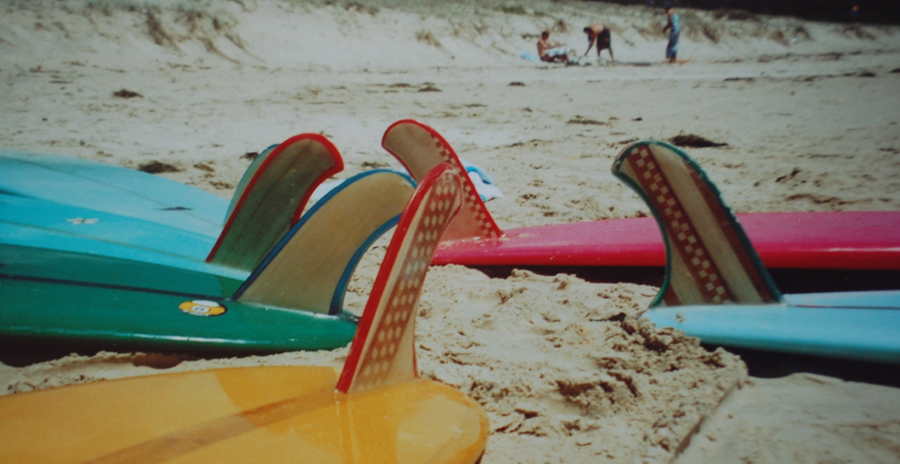
Tom’s Background with Durable Boards: When I was in 7th grade, 1976, I bought my first early 60’s longboard for $11.00. It was a mint condition Wardy that was my favourite board for years. The boards of the 1960’s were made to last. In 1986 I became a team rider for Donald Takayama. He made me beautiful boards but I had to give them back after 6 months because they were still in OK condition and could be sold as used. I never gave them back it time and the deck would delaminate with a big air bubble under the back foot and the board’s value plummeted. Donald would give me a lecture. In my formative years that was the way it was. With California’s Clark foam a board was designed to last 6 months of surfing and then fall apart. Those days never really made it to Australia. The blank manufacturers like Burfords, South Coast and Bennetts never strayed into the stupid consumptionism of the USA. But even in Australia making a proper, super durable board makes the board last a lot longer with less maintenance.
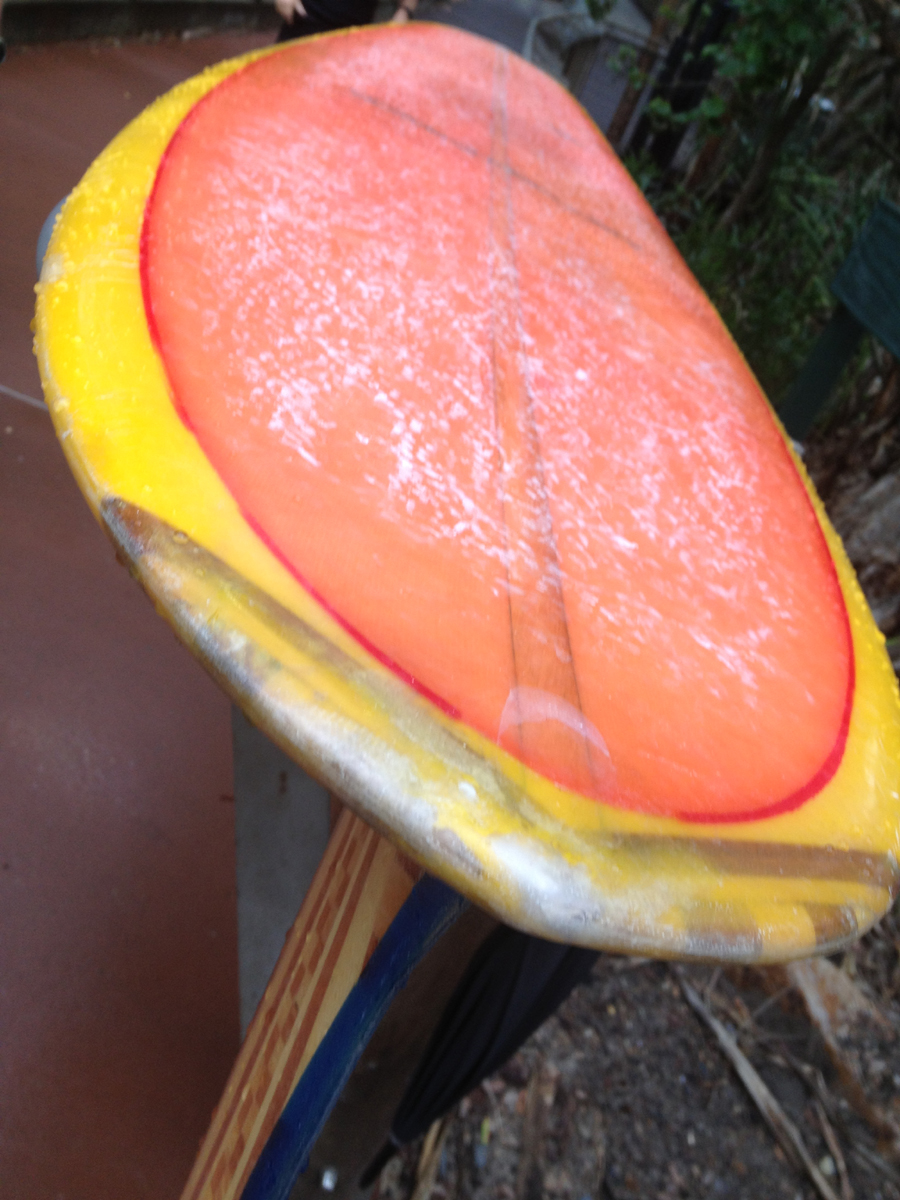
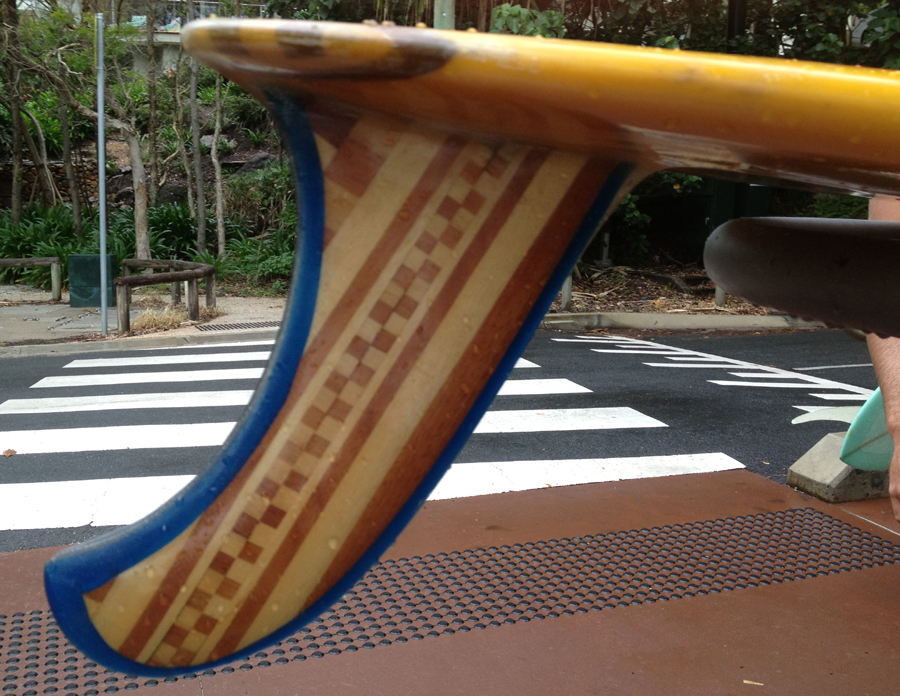
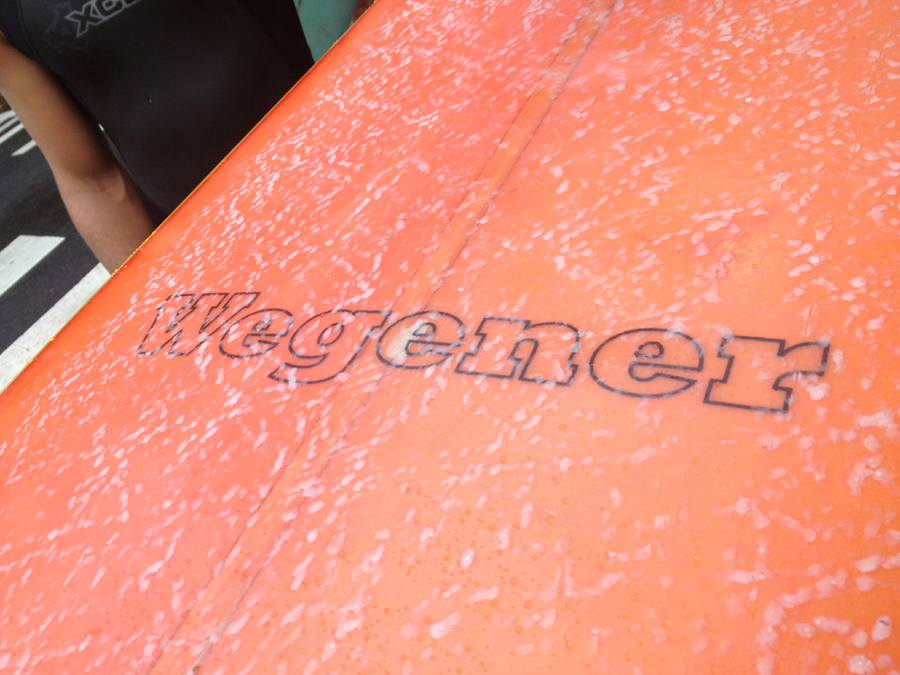
The photos show a board that I made in 2001. After 12 years on constant surfing and many owners including Chris from the band Oka, the board is actually in really good condition. You can see where the pinline has been sanded off in a few places and there are some minor dents. But the tail shape is still good because the wood tail blocks are so strong. They don't ding. The Deck is still like new because of the staggered laminations, thick stringer, and perfectly cut deck rocker.
Perfectly Cut deck Rocker Template: While still in California I worked with many shapers and glasser as well as Walker Foam (who ended up winning the battle with Clark) and learned how to make the most durable foam surfboard. I took this with me when I started making boards in my shed in Noosa. First you need the stringer to be cut exactly to the rocker of the deck of the board. I like to cut and glue my own stringers. If the stringer is perfectly cut and glued then you can take a minimal amount of foam off the deck. The foam on the outside of the blank is much harder than the foam 7mm down. It is like a hard crust and if you keep it on the deck you will not get impressions on the deck from knee paddling or foot placement.
Strong Stringer: The next import element is a strong stringer. Donald ended up making mostly triple stringer for good customers because the boards would last longer. In Australia I found paulownia wood and was able to put ¾ to 2” stringer in. Having a stiff stringer keeps the glass stronger because it does not flex as much. Polyester resin dries very slowly. It takes years. If you really want a board to last get a thick stringer because it will let the glass job cure perfectly.
Nose and Tail Blocks: Nose and tail blocks serve an important purpose. Most dings occur on the nose and the tail. With the wood they are never all that bad and seldom have to be repaired in any hurry. Without the wood you really have to take care of the ding or it will grow and cancer (water getting in the foam and rotting) and the nose or the tail will pull apart. Recently Finley put a ding in a foam board off to the side of the well beaten nose blocks that have never been repaired. I though, “darn, now I will have to fix this all up.” It had been 12 years of surfing.
Tints: Really good tints make a difference. Now the tints are pretty good in Australia, but in 1998 my brother Jon in California got some from our supplier in Japan and send them to me. The colours on the boards I made back then are still in top condition and have not faded.
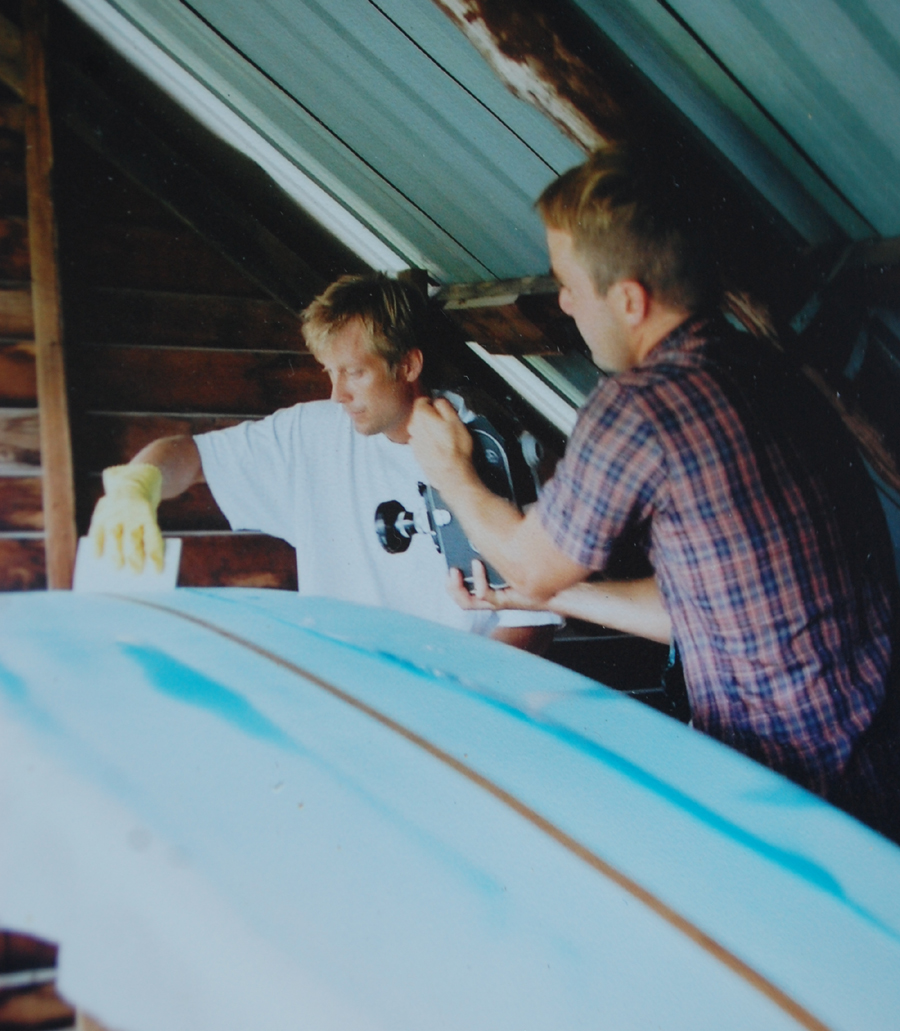
Photo: Thomas Campbell is filming in the years 2000 for the movie Sprout. No mask only for the camera.
Laminations: When it comes to laminating there is one really important method for strength. If you laminate the first layer of cloth and then wait a few days and then put a second lamination over the top the board will be sooooo much stronger. Again, resin dries slowly and if you let the first layer set and then put a second layer on it multiplies the strength. I think it has to do with resin molecules lining up one way with the first and then differently on the next layer. I know that the ending glass job is much stronger than if you did both lams at the same time. Before I turned to wood, I would do my tints on 4 oz first, let them dry for 4 days and then put a clear layer of 6 oz over the top. When the board dings it is almost always the top layer that is damaged and it is easily repaired leaving the tint below perfect. In 2001 I made a beautiful yellow tinted, 12 foot, five stringer board for my friend John Gilroy. He was carefully crawling down the rocks at Nationals with a friend holding the front of the board. By some fluke they both dropped the board at the same time and it smashed all the way down the rocks and into the high tide shore break. One rail was white with cracks. A bit of styrene and very basic ding repair and the board was new again. Only the outer layer of the clear glass was cracked. The tint was unscathed.
Resin Pinlines: The most technically difficult part of the super durable board is the resin pinline. All pinlines now are done with paint. But in the 1970’s they were resin mixt with a tint. The colour never fades on the resin pinline and you can feel the slight bump from the resin under the gloss coat. I really like this feeling because my first store bought board had this. I loved that board. A green 6’6” single fin in 1977. The resin pinline is an added feature of pure class.
Wood Fin: In 1997 I was experimenting with a shape I called Crusader. I made sever versions of the same template to really tune this board in. I made the third board with a balsa wood fin that was light and when I jumped in the water and took my first paddle I could feel how much lighter the whole board felt. It was so much more lively than if the board had a big heavy fibreglass fin. Also, the thicker wood fin on a traditional longboard is much smoother in turning. Water sticks to the curves of a thicker fin better and there is no cavitation. When I make these fins I make them strong with five layers of 6 oz and the thick bead of resin around the fin. I have seen my fins on my boards go through numerous beatings and they come out OK.
I will be making these boards with Matt Williams. He was my apprentice for 5 years. He has bought Factory Surfboards from the legend Paul Carson in Caloundra. Paul glassed hundreds of my boards over the last 10 years. Paul is a master craftsman and teaching Matt. I will be going to the factory and glassing the boards with Matt.
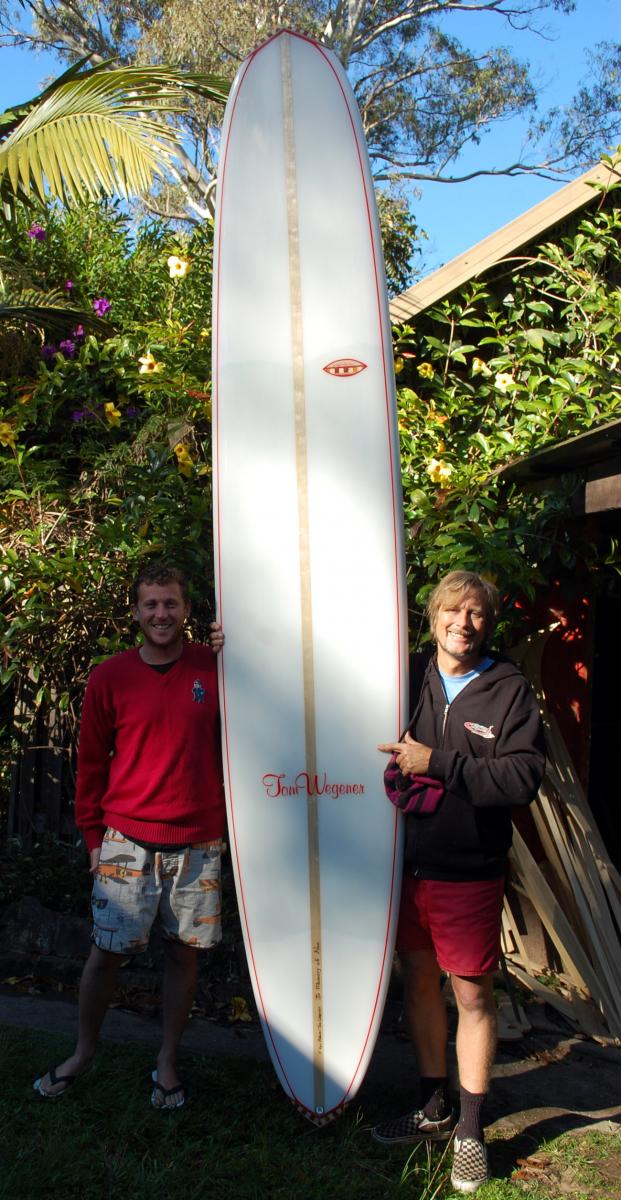
%20of%20adamc06.jpg)
Adam Casey with his new 11' custom Model A and to the righ the older broghter of the same shape from 12 years earler. You could almost sell the old board as new though it has been surfed for years.
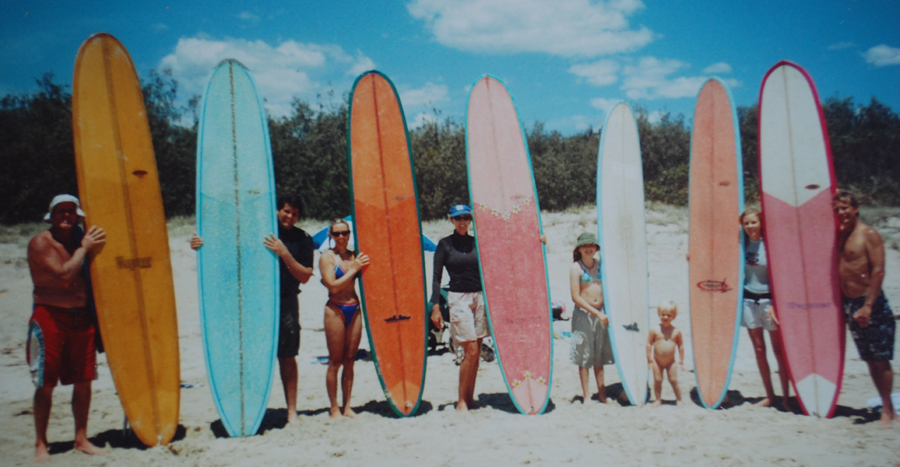
Team Wegener 2001 in Noosa: Col, Jason, The Great Annie, Jane, Rosie, Finley, Zara, and Tom